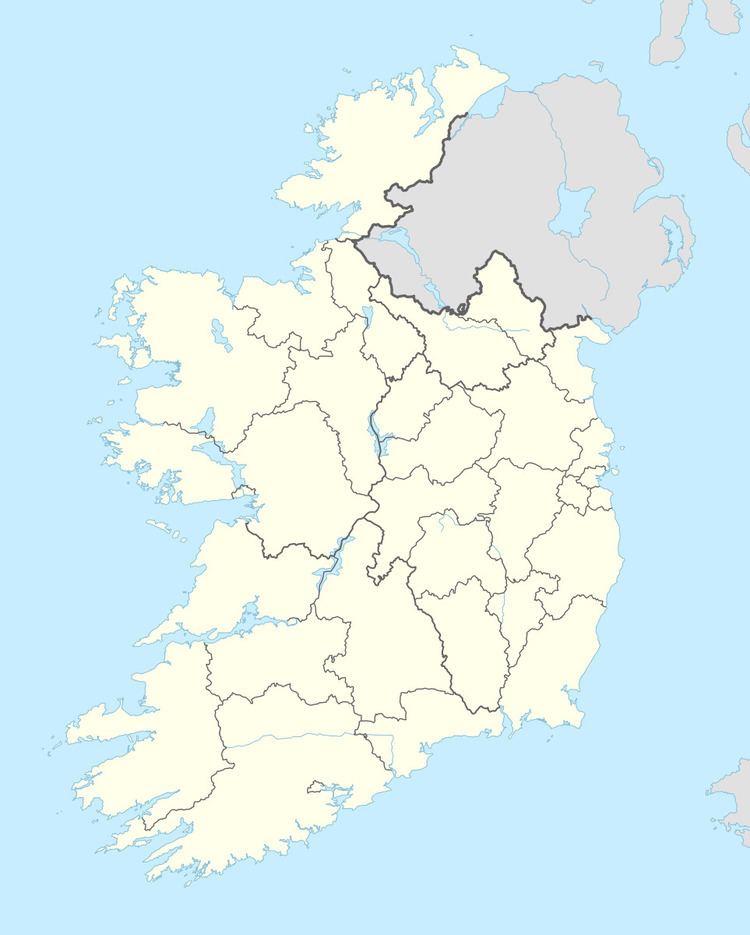Time zone WET (UTC+0) Area 15 km² | Irish Grid Reference N656063 Local time Monday 6:28 PM | |
 | ||
Weather 13°C, Wind SW at 11 km/h, 75% Humidity | ||
Kildangan (/kɪl.ˈdæŋɡ.ən/; Irish: Cill Daingin, meaning "the church of the fort") is a village in County Kildare in Ireland. During the Anglo-Norman settlement of Ireland, Maurice Fitzgerald of Allen built a castle there as part of a defensive line along the River Barrow from Carlow to Lea Castle near Portarlington. Near the castle a church was built which gave the locality its name. The original castle and church were located within the grounds of Kildangan Stud. The castle was dynamited in 1882 and the stone reused to build the existing Victorian Jacobean style house to the design of William Hopkins.
Contents
- Map of Kildangan Co Kildare Ireland
- Location
- Road
- Rail
- Population
- Development
- Religion
- Business
- Sport and Amenities
- People
- References
Map of Kildangan, Co. Kildare, Ireland
Location
Kildangan is situated on the R417 between Monasterevin and Athy. The village lies close to the flood plain of the River Barrow, near the County Laois border. Kildangan is linked to Kildare town by means of the Local Road L3010, which passes through Kildangan Stud.
Road
Kildangan is well served by road, however its location and poor public transport creates a high car dependency.
Rail
Kildangan railway station opened on 15 March 1909 and finally closed on 1 January 1963. Its last station master was Tommy Maher, who was in charge from 1958 until its closure in 1963. Since the closure of Kildangan station the nearest station is Monasterevin railway station around 6 kilometres distant.
Population
Kildangan Village has a population of approximately 555, the vast majority of the population reside outside the village, in the District Electoral Division(DED) of Kildangan and Ballybrackan. Between 1996 and 2011 there was a 151% increase in population of the Kildangan DED as the M7 motorway and increased frequency of rail services from Kildare Town opened up Kildangan for housing development. Kildangan is approximately 60 km from Dublin, and the majority of the population increase is of commuters employed in Dublin City and the Greater Dublin Area. Of the indigenous population Bord na Móna is the main source of employment in the immediate area. Kildangan Stud, and the agricultural sector also constitute a major source of local employment. Population figures are for Kildangan DED, covering an area of 1500 hectares approx and containing the Townlands of Ballygreany, Ballyvarney, Duneany, Fennor, Grangebeg, Kildangan and Rathmuck.
Development
Under the Kildare development plan 2017 to 2023, Kildangan was designated as a Village as it had experienced significant levels of urban generated growth. The main objective of the Development plan is that any new housing shall be predominantly for local needs only. The Plan provides for local demands in accordance with the provisions of the county settlement strategy. The plan also allocates an area for a Village Centre, located on the site of the derelict post office.
Religion
In the parliamentary return of 1731, Richard Foxcroft, Vicar stated "in the parish of Kildangan there is no mass house built, but the priest of Lackagh say Mass often at the back of the old chapel there". The present Catholic church was built in 1792 on a site provided by the O'Reilly family and is a protected structure. The church was enlarged in 1849 by Susan O'Reilly, grandmother of Roderic More O'Ferrall. A brass plaque at the rear of the center aisle reads "In memory of Dominick O'Reilly of Kildangan Castle who was born on the 16th of June 1786 and died on the 15th of July 1845 and of his wife Susan Cruise of Feamore, Co Mayo who died on the 6th of December 1839 and of their children Eliza and Anne who died in early Youth. Their sole surviving child, Susan O'Reilly, has erected this tablet to her parents and sister in affectionate remembrance of their virtues and their love and she entreats the prayers of the faithful for their souls. Their bodies are interred in Kildangan grave yard"
The church tower and bell were added in 1881.The church is dedicated to "Our Lady of Victories" Kildangan (along with Nurney) formed part of Monasterevin Parish until 2007, when both came under control of St Brigids Parish, Kildare.
Business
Business in Kildangan Village consists of Kildangan Stud, Crosskeys public house, Gala filling station, a chip shop and a few small home businesses. The filling station supplies every day needs, motor fuel, and a postal point. Kildangan post office closed in 2004, and is now derelict.
Kildangan Stud was founded by the More O'Ferrells on the site of Kildangan Castle. The grounds contain a large variety of rare ornamental trees and shrubs, and an abundance of woodland. Kildangan Stud was sold in 1986 by Roderic More O’Ferrall to the Maktoum family, who invested large sums of money in it.. Prior to the sale to the Maktoum family the Stud farm was offered to the Irish State, however the offer was allowed lapse by the Haughey Government.
Kildangan Education Centre is a preschool facility in the Village Centre Development which opened on 31 August 2011. The preschool provides a free year of education to all children before they begin primary school, as well as providing part-time sessions for children from 2 years and 6 months. An adult education centre in the adjoining unit which opened officially in March 2012 provides adult classes and support classes for second level students. The centre also provides children's classes such as cookery, Irish, French, art, and drama.
Racehorse trainer Michael Halford established a stable in Doneany, three kilometers from Kildangan Village in 2008.
